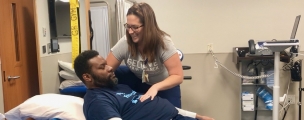As a college senior, I was diagnosed with Guillain Barre Syndrome (GBS), an autoimmune disease that effects the nervous system. A subsequent diagnosis of CIDP (Chronic Inflammatory Demyelinating Polyneuropathy) was later made. Despite functional disabilities and the need for ongoing treatment, I was able to complete medical school and residency. As an attending physiatrist and Assistant Medical Director at Magee, my experiences as a patient living with this diagnosis have allowed me to make some special connections with my patients and their care givers. In this blog, I want to offer some education on GBS that can hopefully help you or a loved one.
What is GBS?
In general, it is an inflammatory disorder of the nerves outside the brain and spinal cord. It is characterized by the rapid onset of numbness, weakness, and often paralysis of the legs, arms, breathing muscles, and face.
What causes GBS?
Although the specific cause is unknown about 50-60% of cases occur shortly after a bacterial or viral infection within 8 weeks preceding symptoms, some as common as the stomach flu or respiratory infection. Some theories suggest an autoimmune trigger, in which the patient’s defense system of antibodies and white blood cells attack the nerves in the body, damaging the nerve covering (myelin) causing numbness and weakness.
What are the symptoms?
The most common initial course is the rapid onset of weakness, frequently accompanied by abnormal sensations (numbness, tingling) that affect both sides of the body similarly starting in the hands and feet and progressing up the arms and legs. Loss of reflexes, such as the knee jerk, are usually found. There may also be muscle, joint and back pain that may radiate into the legs and arms. Weakness of the face muscles and vision changes may also occur.
As the disease progresses there may be increased weakness/paralysis of the limb muscles (tetraplegia) and/or respiratory muscles sometimes requiring the assistance of a ventilator (15-30% of those diagnosed). There may be difficulty swallowing and issues with bladder and bowel function. Blood pressure, heart rate and sweating may also be effected.
How is GBS treated?
In its early stages, GBS is unpredictable, so except in very mild cases, most newly diagnosed patients are hospitalized and admitted to the ICU (Intensive Care Unit) for close monitoring of breathing, heart rate, blood pressure and other body functions until the disease is stabilized.
The main treatments include plasma exchange (also called plasmapheresis) and administration of intravenous gamma globulin (IVIG). Plasma exchange (a blood “cleansing” procedure) is thought to remove circulating antibodies that are attacking the nerves. Although there are many theories, the precise mechanism for IVIG in GBS is unknown.
How does rehabilitation help?
It is estimated that 40% of those diagnosed will require inpatient rehabilitation once the medical issues have stabilized and close monitoring in the ICU is no longer required. Inpatient rehabilitation at Magee involves the coordinated treatment by a multidisciplinary rehabilitation team including a physiatrist (rehabilitation physician), physical therapist, occupational therapist, case manager, nurse, psychologist, clinical nutritionist and possibly speech and respiratory therapist. The inpatient therapists will work to prevent joint contractures, improve strength, function and mobility while avoiding overwork weakness, assess the need for adaptive equipment for activities such as grooming, dressing, bathing and eating. If appropriate they will initiate gait training while assessing the need for bracing and work to improve swallowing and speech skills. The team will work to prevent skin breakdown, manage bowel and bladder function, insure adequate nutrition, prevent blood clots, manage pain, improve respiratory status and provide emotional support. Recovery and continued improvement in strength and function can continue for six months to two years after the initial diagnosis.
Living with GBS
The recovery period may be as little as a few weeks or as long as a few years depending on the severity of symptoms. It is estimated that long term approximately 15% of people will have no residual effects and about 30% will have a residual weakness after 3 years. The most common cause of long term disability is weakness which occurs 5 to 10% of the time. Other common long term disabilities include pain and fatigue. There is a 2-3% recurrence rate occurring anywhere from 2-47 months from the initial diagnosis.
Are they doing research for a cure?
Scientists are concentrating on finding new treatments and refining existing ones. They are also looking at the workings of the immune system to find which cells are responsible for attacking the nervous system. Since so many cases of GBS begin after a viral or bacterial infection, this suggests that certain characteristics of some viruses and bacteria may activate the immune system inappropriately. Investigators are searching for those characteristics. In addition, research involving myelin being conducted for diseases such as GBS and MS (multiple sclerosis) are working on identifying the targets for the immune system and myelin regeneration.
For information and support services, contact the GBS/CIDP Foundation International. For more on GBS services at Magee, click here.
Photo: Dr. Doherty with her husband Roger
References
Buchwald B, Ahangari R, Weishaupt A, Toyka KV. Intravenous immunoglobulins neutralize blocking antibodies in Guillain-Barrésyndrome. Ann Neurol. 2002;51(6):673.
Dalakas MC. The use of intravenous immunoglobulin in the treatment of autoimmune neuromuscular diseases: evidence-based indications and safety profile. Pharmacol Ther. 2004;102(3):177.
Feasby, Thomas E. Inflammatory Demyelinating Polyneuropathies. Neurological Clinics 1992; 10: 651-671.
Guillain-Barre Syndrome Study Group. Plasmapheresis and acute Guillain-Barre Syndrome. Neurology 1984;35;1096-104.
Jacobs BC, O’Hanlon GM, Bullens RW, Veitch J, Plomp JJ, Willison HJ. Immunoglobulins inhibit pathophysiological effects of anti-GQ1b-positive sera at motor nerve terminals through inhibition of antibody binding. Brain. 2003;126(Pt 10):2220.
Meythaler, JM et al. Anemia in Guillain-Barre syndrome patients admitted to rehabilitation. Archives of Physical Medicine and Rehabilitation 1994; 75:1051.
Meythaler, JM. Rehabilitation of Guillian-Barre Syndrome. Archives of Physical Medicine and Rehabilitation 1997; 78: 872-879.
Ropper, Allan. The Guillain-Barre Syndrome. The New England Journal of Medicine 1992; 326: 1130-1135.
Sejvar JJ, Baughman AL, Wise M, Morgan OW. Population incidence of Guillain-Barré Syndrome: a systematic review and meta-analysis. Neuroepidemiology. 2011;36(2):123-33. Epub 2011 Mar 21.
Van der Meche FGA, Schmitz PIM, Dutch Guillain-Barre Syndrome Study Group. A randomized trial comparing intravenous gamma globulin and plasma exchange in Guillain-Barre syndrome. N Engl J Med 1992;326;1123-9.
Yuki N, Hartung HP. Guillain-Barré Syndrome. N Engl J Med. 2012 Jun;366(24):2294-304.







